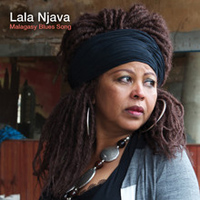
|
MALAGASY GUITAR MASTERS
VOLO HAZO (Carthago music)
Madagascar entered our consciousness with the wild home-made zither of bicycle spokes on the famous OCORA Valiha albums. Now a generation later three masters of more orthodox six-stringed guitar get together to jam and show off their jazzy chops. They are Teta Jean Claude, son of an accordionist, who plays tsapiky style, which is traditional, though his influences are Hendrix, jazz and blues. Chrisanto Zama is self-taught and a mainstay of the Ny Malagasy Orkestrail who play rhythmic music for wrestling matches as well as funerals. Joel Rabesolo is considered one of the most versatile guitarists on the island and also loves jazz. At first I heard Georgian bouzouki music in here, but that is possibly the last influence you could expect. As you know Madagascar is a big island off the Southeast coast of Africa, so the mainland influences come from South Africa and Kenya as well as Congolese guitar which influenced everyone. The Kenyan flavor is more likely Taarab than Benga, but there is also the Arab lute music that drifted down from Yemen. The pervasive valiha sound, on the other hand, can be traced to Indonesia, according to the liner notes. There are traditional tunes here, used at various rituals, but also modern ones played purely for entertainment, and if you need a benchmark, say Django, they rip up a wild version of Ellington's "Caravan." The recording is superb: produced by Tao Ravao, himself a guitarist who has recorded D'Gary, Rajery and even Sekou Diabaté of Bembeya Jazz.
|

|
This is apparently the second volume of fields recordings made by Charles Brooks who spends a lot of time in Madagascar. He has assembled a dozen folkloric tracks played on the valiha and other indigenous instruments. The valiha is a unique metallic zither made from recycled wrecked bicycle wheels. The other instruments heard here are equally unique: lokanga (another metallic-sounding guitar-like instrument attached to a gourd resonator), kabosy (more like a mandolin, with four to six strings made of fishing wire), and jejolave (a one-stringed musical bow, like a berimbau, again with a gourd resonator). On the acapella "Banaika" (which closes side A) the harmony singing is interesting because the chorus seems to be on a different "page" from the lead vocals, creating wonderful counterpoint and tension. Side B kicks off with dueling pennywhistle flutes and a soft susurration like a rain stick which mimics the sound of insects. Prosper Razafimamdimby comes in with a "5-stringed violin", though it has the plucked metallic twang of the valiha. He has a pleasant soft but raspy voice that matches the tone of his instrument.
|

|
LALA NJAVA
MALAGASY BLUES SONG (Riverboat TUGCD 1069)
With her throaty voice, Lala Njava may remind you of Cesaria Evora or other African songstresses who have broken through to Western listeners. Njava has a good shot at this hope for a breakout with her strong solo debut. The opening track, "Soa Gnanay," has familiar instrumentation: acoustic and electric guitar, bass and drums. There's a ton of echo on the guitar, but just as it starts to get deep, it ends. All the songs are short. She has a cracked bluesy voice, which you will love or hate. For the second cut an accordeon and a banjo join in. Her band is a family business (including her sisters) and as Njava they moved to Europe in 1990 and cut some tracks for Deep Forest, who should remain nameless. Despite her new base, she still sings about Madagascar and the many problems in her homeland: strife and the struggle for women's rights. The guitarists have been listening to a wide range of music: I can hear a Malian influence in the acoustic guitar (on "Sweet Lullaby") played by Dozzy Njava, as well as Nigerian afro-funk in the bass (on "Pardon à l'Africa") played by Maximin Njava. This is a very enjoyable set from some highly accomplished musicians.
|

|
ROUGH GUIDE TO MADAGASCAR (RGNET 1163CD)
Sailing south down the East coast of Africa we come to Madagascar, a huge diversified island with a lot of interesting music. Back in the 70s we grooved to the OCORA Valiha album with its eerie sounds coming from plucked bicycle spokes & brake cables. Like other strife-torn African countries Madagascar has musical currents that thrive in adversity. Ian Anderson (of Froots and not Jethro Tull, I imagine) put together this album which starts with the pop sounds of Jaojoby from, it seems, years ago. Their four bars of fame are a speeded up version of "Hey Joe" proving that good pop riffs never die. But then there are musical affinities that recur coincidentally, so it's probable that D'Gary knows Bert Jansch's "Blackwater side" from the first Led Zep album, but can I really say it's the source of his "Zera Somondrana"? This is a pure pop album which may not wear as well as the deeper folkloric stuff, although the persistent valiha and percussion drive of Daniel Tombo's "Taraka" is folksy enough, and really gets under your skin. The other folk tracks are the most appealing to me: Vilon'Androy's fiddle piece has foot-stamping accompaniment that is supposed to echo the sound of cattle rustlers. Toto Mwandjani's dombolo guitar is bright and accomplished; Claude Teta of the band Teta plays blistering, skirling pop guitar that reminds me of Bikutsi music. But there's a lot of lightweight fluff on here, like the cute furry lemurs that populate the island. Maybe it's the French influence, or the sea shanty detritus that washed ashore in some accordion parts, transposed to indigenous instruments like the marovany. The speedy dances, in 6/8 time, dominate the pop stuff on here and it is exhausting but fun if you are in the mood to bop about.
|



